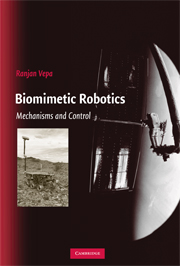Book contents
- Frontmatter
- Contents
- Preface
- Acronyms
- 1 The Robot
- 2 Biomimetic Mechanisms
- 3 Homogeneous Transformations and Screw Motions
- 4 Direct Kinematics of Serial Robot Manipulators
- 5 Manipulators with Multiple Postures and Compositions
- 6 Grasping: Mechanics and Constraints
- 7 Jacobians
- 8 Newtonian, Eulerian, and Lagrangian Dynamics
- 9 Path Planning, Obstacle Avoidance, and Navigation
- 10 Hamiltonian Systems and Feedback Linearization
- 11 Robot Control
- 12 Biomimetic Motive Propulsion
- Answers to Selected Exercises
- Appendix: Attitude and Quaternions
- Bibliography
- Index
7 - Jacobians
Published online by Cambridge University Press: 20 February 2010
- Frontmatter
- Contents
- Preface
- Acronyms
- 1 The Robot
- 2 Biomimetic Mechanisms
- 3 Homogeneous Transformations and Screw Motions
- 4 Direct Kinematics of Serial Robot Manipulators
- 5 Manipulators with Multiple Postures and Compositions
- 6 Grasping: Mechanics and Constraints
- 7 Jacobians
- 8 Newtonian, Eulerian, and Lagrangian Dynamics
- 9 Path Planning, Obstacle Avoidance, and Navigation
- 10 Hamiltonian Systems and Feedback Linearization
- 11 Robot Control
- 12 Biomimetic Motive Propulsion
- Answers to Selected Exercises
- Appendix: Attitude and Quaternions
- Bibliography
- Index
Summary
Differential Motion
In Chapters 4 and 5, direct kinematics and inverse kinematics of manipulators, relating the position of the end-effector in base coordinates to the joint coordinates and vice versa, were considered. These relationships represent transformations from one set of coordinates to the other. However, in the context of forces acting at the joints, the definition of these transformations is incomplete. Although the work done by the joint forces is a scalar, it may be expressed as a surface or volume integral in the space defined by the coordinates. Thus it is important to relate the volume of an element in the Cartesian frame to the volume of an element in the frame defined by the joint coordinates. This relationship was first demonstrated by Carl Gustav Jacob Jacobi (1804–1851). Jacobi, who hailed from a family of Prussian bankers, worked at the University of Königsberg. He arrived there in May 1826 and pursued an academic career in pure mathematics. There he worked on, among other topics, determinants and studied the functional determinant now called the Jacobian. Although Jacobi was not the first to study the functional determinant that now bears his name, as it appears that the functional determinant was mentioned in 1815 by Cauchy, Jacobi wrote a paper on De determinantibus functionalibus in 1841 devoted to this determinant. He proved, among many other things, that if a set of n functions in n variables is functionally unrelated or independent, then the Jacobian cannot be identically zero.
- Type
- Chapter
- Information
- Biomimetic RoboticsMechanisms and Control, pp. 120 - 141Publisher: Cambridge University PressPrint publication year: 2009

